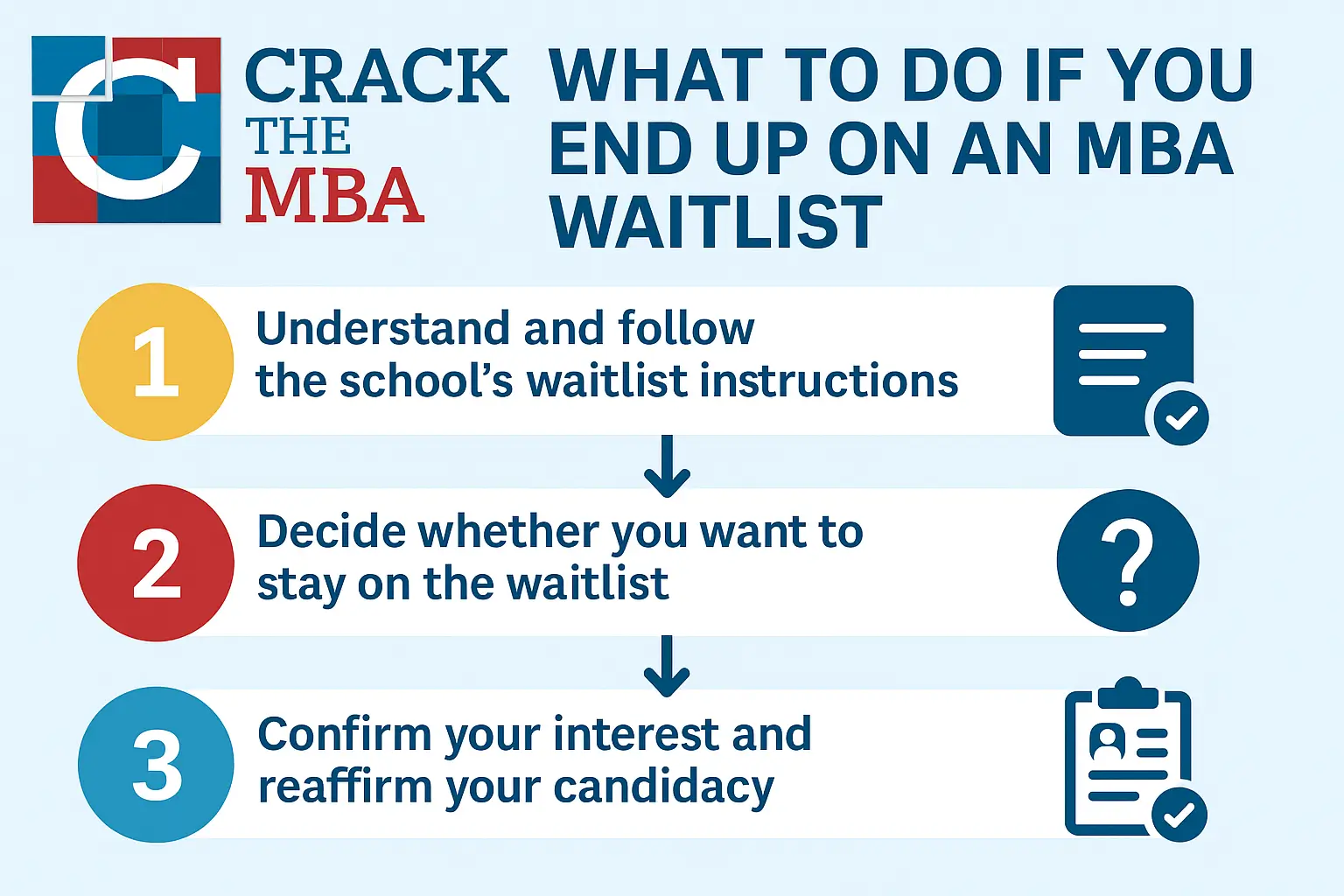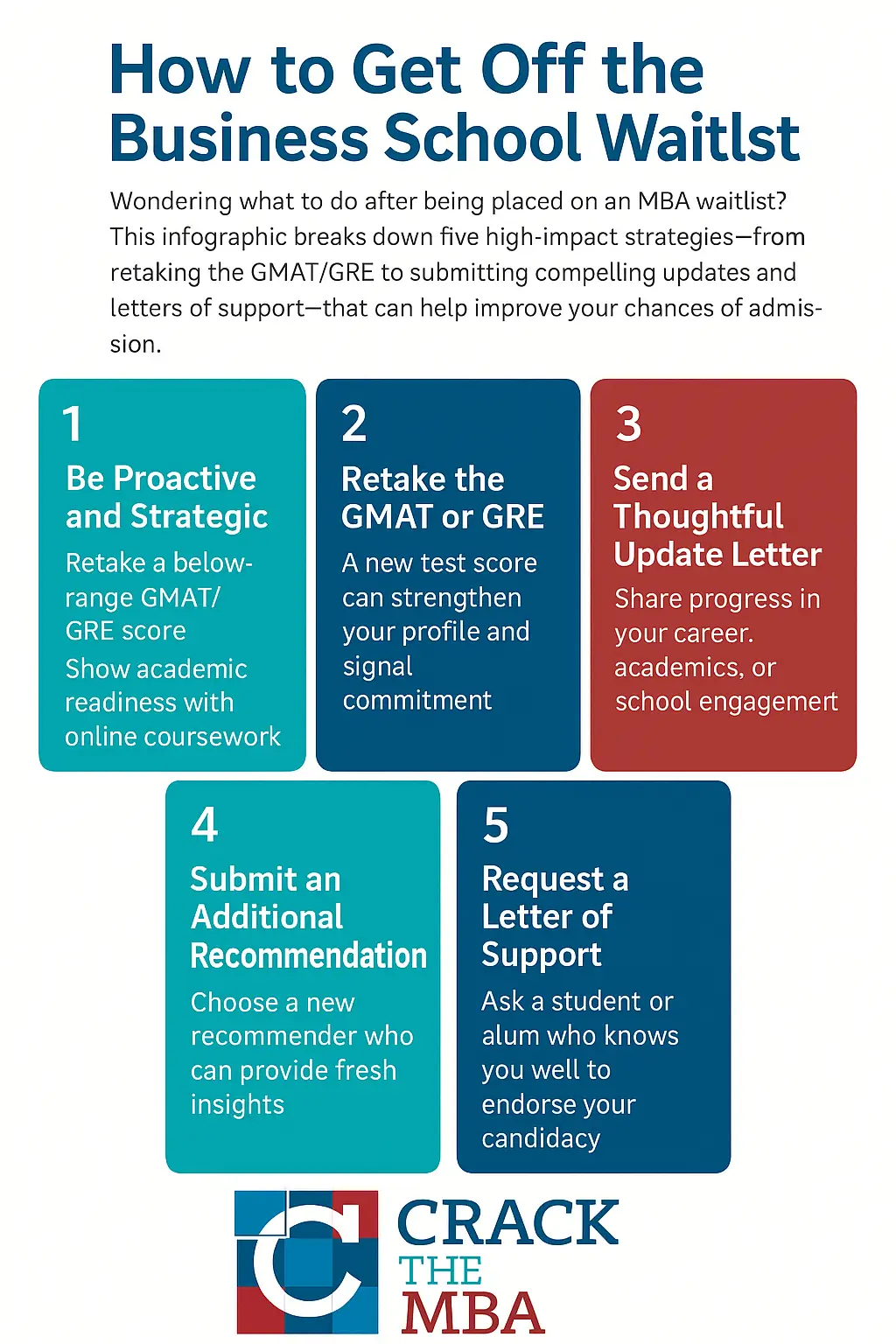MBA Waitlist Guide: What It Means & How to Get Off It
You’ve just heard back from your dream MBA program, but instead of an acceptance or a rejection, you’ve been placed on the MBA waitlist. Now what?
For many applicants, the hardest part of landing on a business school waitlist is the ambiguity. Unlike an admit or deny decision, the waitlist offers no certainty, no clear next step. What does it mean? Can you do anything to influence the outcome? And if so, how?
At Crack The MBA, we view being waitlisted not as a setback, but as an opportunity, a second chance to prove your fit, strengthen your case, and ultimately earn that offer. If you’re still in the game, you still have a shot. And that’s a reason to stay engaged and optimistic.
To navigate the waitlist effectively, you first need to understand why MBA programs use them in the first place.

Why Do Business Schools Have Waitlists?
Waitlists are a strategic tool for business schools to manage enrollment, optimize yield, and shape the most competitive and well-balanced class possible. Admissions committees face uncertainties, and therefore, they make offers without knowing exactly how many admitted candidates will accept. For example, even after sending out admit decisions, some candidates may withdraw late or fail to show up — yes, even as late as orientation.
We once spoke with an admissions officer at an M7 program who confirmed that yield uncertainty can persist right up to the moment students arrive on campus. This is why waitlists exist: they give schools flexibility and insurance as they finalize the incoming class.
Beyond yield management, waitlists also help schools:
- Improve their class profile metrics (like average GMAT or GPA)
- Maintain diversity across industries, geographies, and demographics
- Respond to shifting application volumes between rounds
Sometimes, candidates are placed on the waitlist even before the interview stage. Schools like Harvard Business School, NYU Stern, and Duke Fuqua often use pre-interview waitlists to evaluate interest, assess yield potential, or wait for more applications before deciding whether to move forward.
At high-touch programs like Stern and Fuqua, this can also signal a request: demonstrate genuine interest, connect with the community, and show the admissions team that you truly want to be there. Engagement signals yield likelihood, and yield matters more than ever.
The bottom line? While many elements of the MBA waitlist process are outside your control, how you respond to being waitlisted is entirely within it. And that’s what we’ll help you master in this guide.
Why are you on an MBA waitlist?
Being placed on a business school waitlist is not a rejection; in fact, it’s often a sign that the admissions committee sees promise in your application. Your profile was strong enough to stay in contention, but a final decision couldn’t be made then. In many cases, the decision to waitlist is not a reflection of a weakness, but rather a result of the school managing class size, yield, or profile balance.
So, why might you have landed on the MBA waitlist? Here are some of the most common reasons:
1. Your GMAT/GRE Score Is Competitive, But Not Strong Enough for Your Applicant Pool
Even if your test score is close to or above the class average, it may be less competitive within your specific applicant pool. For example, Indian applicants or applicants from overrepresented industries like consulting or tech may need scores significantly higher than the average to stand out. Schools evaluate candidates within peer groups to ensure diversity and balance.
2. Your Profile Is Strong But Not an Immediate Priority
The admissions team may view your background as compelling, but they’re waiting to see how other candidates in later rounds perform before making a final call. If space opens up, especially due to non-yielding admits, you could be offered a seat.
3. Your Demonstrated Interest in the Program Was Lacking
Many top schools care deeply about demonstrated fit and interest. If you haven’t engaged meaningfully with the school through campus visits, virtual events, alumni conversations, or essays tailored to the program, admissions teams may question your intent to enroll. This can be especially critical at high-touch schools like Duke Fuqua and NYU Stern.
4. Your Professional Trajectory Is Slightly Less Impressive Than Your Peers’
While your career to date may be solid, the admissions committee might see you as slightly less accomplished than other applicants from similar industries, roles, or geographies. This doesn’t mean you’re not capable, just that others may have shown more rapid progression, leadership, or impact.
5. Limited Community Engagement or Extracurricular Involvement
Top MBA programs value well-rounded applicants who actively contribute to communities outside of work. If your application didn’t show enough depth in extracurriculars, leadership in volunteer settings, or social impact, this could weaken your positioning relative to others.
6. High Competition Within Your Applicant Demographic
In highly competitive applicant pools, such as Indian male engineers, Chinese finance professionals, or U.S.-based consultants, even very strong profiles can get waitlisted due to volume alone. Schools need to ensure diversity across regions, functions, and life experiences.
What to do if you end up on an MBA waitlist
Landing on the MBA waitlist can feel like you’re stuck in limbo, not accepted, but not rejected either. The first thing to do? Don’t panic. Take a breath, assess your situation, and then respond with strategy and professionalism.

Here’s how to navigate your next steps wisely:
Step 1: Understand and Follow the School’s Waitlist Instructions
Every business school waitlist operates differently. Some schools welcome updates, while others clearly state they want no further communication. Your first responsibility is to carefully read the instructions provided by the admissions office and adhere to them without exception.
- If the school invites updates, you’ll have the opportunity to submit new achievements or a letter of continued interest.
- If the school explicitly prohibits contact, respect their wishes. Pushing boundaries here can hurt your chances.
Most schools will be transparent about what’s allowed. Follow all instructions exactly as outlined in their waitlist communication or applicant portal. Ignoring guidelines is a fast way to get ruled out.
Step 2: Decide Whether You Want to Stay on the Waitlist
Being waitlisted doesn’t require an automatic “yes.” Take the time to reflect: Is this school still your top choice? Are you willing to wait weeks or months for a possible offer?
Consider factors such as:
- Your interest level: Would you accept an offer immediately if it came through?
- The school’s yield rate: Yield is the percentage of admitted applicants who enroll. A lower yield often translates to more waitlist movement.
- For example, Stanford GSB and Harvard Business School have historically high yields (~85–90%), meaning fewer spots open up from the waitlist.
- Schools like Kellogg or Yale SOM may have more room for movement due to yield rates in the 40–50% range.
If the school is a top choice and you’re competitive, it makes sense to remain on the list and prepare your next steps.
Step 3: Confirm Your Interest and Reaffirm Your Candidacy
If the school allows communication, respond promptly and professionally to confirm your continued interest.
- Thank the admissions committee for the opportunity to remain under consideration.
- Reiterate your genuine enthusiasm for the program and state clearly that you would accept an offer if admitted.
- Clarify that the school remains a top choice, especially if you’re confident your academic and professional credentials align well with the school’s standards (e.g., a strong GMAT/GRE score or a standout work profile).
Sometimes, applicants are waitlisted not because of weaknesses in their profile, but because the admissions team isn’t sure they’ll enroll. You can address this uncertainty directly and effectively by expressing sincere intent to attend.
If communication is permitted, this is also a good time to begin thinking strategically about:
- Updates to your profile (promotions, test score improvements, community impact)
- A strong letter of continued interest (more on this in the next section)
- Recommendations or endorsements (only if allowed)
Do you want to get off the business school waitlist?
At Crack The MBA, we have helped hundreds of students get into top MBA programs around the world. We would be happy to help you too. Get in touch with us to learn more about our MBA application services.
How to Get Off the Business School Waitlist
Being waitlisted at a top MBA program doesn’t mean the door is closed; it means your application is still under active consideration. With the right actions and mindset, you can significantly increase your chances of converting your business school waitlist status into an admit.

Here are the most effective steps to take:
1. Be Proactive and Strategic
The most successful waitlist candidates take initiative but only in ways that add real value.
- Improve your profile: If your GMAT/GRE score is below the competitive range (especially for your demographic pool), consider retaking the test. For example, Indian engineers often face higher test score expectations than the overall class average.
- Show academic readiness: If your undergraduate GPA is on the lower side or lacks quantitative coursework, you can enroll in online business fundamentals programs like MBA Math, Coursera Finance courses, or HBS Online CORe to demonstrate intellectual commitment.
- Update ongoing activities: Even if you don’t have time to start new extracurriculars, highlight progress or leadership in existing community or volunteer efforts.
2. Retake the GMAT or GRE (If Needed)
Improving your test score even marginally can make a meaningful difference, particularly if you’re applying from a competitive applicant pool. Schools often compare candidates within demographic or professional buckets, so enhancing your academic indicators can improve your position.
- Don’t just aim for the school’s average; research the average score range for your subgroup (e.g., international male engineers, U.S. liberal arts grads, etc.).
- A new GMAT or GRE score not only strengthens your file but also signals commitment and seriousness.
3. Send a Thoughtful Update Letter (If Allowed)
If the school allows communication while you’re on the waitlist, a well-crafted update letter, also called a Letter of Continued Interest (LOCI), is one of the most powerful tools at your disposal.
What to include:
- A thank-you note for remaining under consideration.
- A clear statement reaffirming that the school is your top choice and that you will enroll if admitted.
- Updates on professional developments: promotions, leadership roles, and new projects.
- Academic updates: new test scores, certifications, or completed courses.
- Engagement proof: events or webinars attended, meaningful conversations with students, alumni, or faculty, along with insights gained from these interactions and how they reinforced your fit with the program.
Timing tip: Wait 1–2 weeks after being placed on the waitlist before sending the update, unless otherwise specified. This gives the admissions team time to assess yield and movement. Also, attend any waitlist webinars or school-hosted events schools like Duke Fuqua, for instance, provide direct guidance and opportunities to engage with waitlist managers.
4. Submit an Additional Letter of Recommendation (If Permitted)
Some programs accept (and even encourage) supplemental recommendation letters from new recommenders.
Best practices:
- Choose someone who can provide fresh insight into your candidacy — ideally covering a new perspective or more recent accomplishments.
- Avoid repeating stories or qualities already covered in your initial recommendations.
- If possible, ask an MBA alum from the school who knows you well professionally or personally — this adds both credibility and relevance.
5. Request a Letter of Support from a Current Student or Alumnus
A letter of support is distinct from a formal recommendation. It’s a brief, informal endorsement by someone who is either enrolled in or graduated from the program — and who can personally speak to your fit with the school’s community.
Tips:
- The individual should know you well, even if you’ve never worked directly together.
- The letter can focus on shared values, your cultural or community fit, or how you would enrich the classroom experience.
- If the recommender is a respected alum in your industry or function, it can carry significant weight.
Do you want to get off the business school waitlist?
At Crack The MBA, we have helped hundreds of students get into top MBA programs around the world. We would be happy to help you too. Get in touch with us to learn more about our MBA application services.
Things NOT to do while on an MBA waitlist
Don’t pester the admissions committee
Even though it’s good to be in touch with the admissions committee if they allow you, you should also be considerate in your communication. Be proactive but not overbearing. Always keep in mind that the admissions committee is looking at how well you interact with others and represent the school to potential employers. After all, business schools care about their reputation in the community. Make sure you live up to the reputation.
Don’t speak poorly about the school
You should try to keep a great attitude even if you’re feeling down or worried. It would be in poor taste to complain about the school where you intend to receive your education.
Don’t just wait around
Your waitlist status shouldn’t discourage you from working to strengthen your application. Make the most of this window of opportunity by enrolling in additional courses or gaining volunteer experience to bolster your application. These actions could help sway the admissions committee and admit you to the program, especially when choosing between two similar candidates. Furthermore, interest in the school will help convey your continued interest in their program.
Don’t approach the admissions committee without a plan
If you try to get in touch with the MBA admissions committee without a strategy, you run the risk of coming across as confused or less confident. The adcom wants to see that you are genuinely interested in their MBA program, so they’ll look more at your actions than your words or intentions. Therefore, give all of your attention to strengthening your candidacy first, and then approach them on how you plan to do it.
Don’t lose hope
If you have been placed on the MBA program’s waitlist, it just means that you are still in consideration for admission. Keep working on improving your application by following the advice we mentioned above. If you follow these steps, you will increase your chances of being taken off the MBA waitlist and accepted into your preferred program.
Final Thoughts
Landing on the MBA waitlist can be emotionally taxing, a mix of hope, uncertainty, and the desire to take control of your future. But remember this: being waitlisted means the admissions committee saw real promise in your application. You’re still in the running.
The most successful waitlisted candidates are not only qualified, they’re also proactive, patient, and strategic. Whether you’re retaking the GMAT/GRE, submitting a compelling update, or simply reaffirming your interest, every action you take can reinforce your commitment and elevate your standing.
Above all, stay engaged but respectful of each business school’s waitlist policy. Follow instructions carefully, avoid unnecessary communication, and use every permitted opportunity to demonstrate growth, fit, and enthusiasm.
You may not have full control over the outcome, but you absolutely have control over how you respond. Use that to your advantage — and keep the faith. Many applicants convert waitlist status into admits each year. You could be next.
Please get in touch with us if you have any questions about the waiting list or the MBA application process.
FAQs: MBA Waitlist and How to Navigate It
1. What does it mean to be placed on an MBA waitlist?
Being placed on the MBA waitlist means the admissions committee sees potential in your application but isn’t ready to offer admission yet. You’re still under consideration, and your final status will depend on available seats, yield rates, and how your profile compares to other applicants in the pool.
2. Is being waitlisted for an MBA program a bad sign?
No. Being waitlisted is not a rejection. It’s a signal that you’re a competitive candidate. While it can be frustrating due to the uncertainty, many applicants successfully convert waitlist status into offers through thoughtful follow-up and strategic updates.
3. How can I improve my chances of getting off the business school waitlist?
To increase your chances:
- Submit a Letter of Continued Interest (LOCI) if allowed
- Provide meaningful updates (e.g., promotion, new test score, relevant coursework)
- Reaffirm that the school is your top choice
- Engage with the school through events, webinars, or alumni conversations
- If permitted, submit an additional recommendation or letter of support
4. Can I contact the admissions committee while on the waitlist?
That depends on the school. Some business schools encourage communication, while others request no contact. Always follow the instructions provided in your waitlist notification or applicant portal.
5. Should I retake the GMAT or GRE if I’m on the waitlist?
If your test score is below the competitive range for your applicant pool, retaking the GMAT or GRE can help. Even a modest score increase can strengthen your profile and signal commitment to the program.
6. What’s the difference between a letter of support and a recommendation letter?
A recommendation letter is a formal part of your application, typically from a supervisor or colleague. A letter of support, on the other hand, is an informal endorsement — often from a current student or alum — that speaks to your fit with the program and your likelihood of contributing meaningfully to the school community.
7. Do all MBA programs have a waitlist?
Most top business schools maintain some form of a waitlist to manage yield and class composition. Policies vary widely — some offer clear instructions and engagement opportunities, while others operate waitlists in a more passive or closed format.
Author
Recent Posts
Archives
Ready for Expert Guidance?
Get personalized support to craft your winning MBA application.
Schedule Free Consultation






